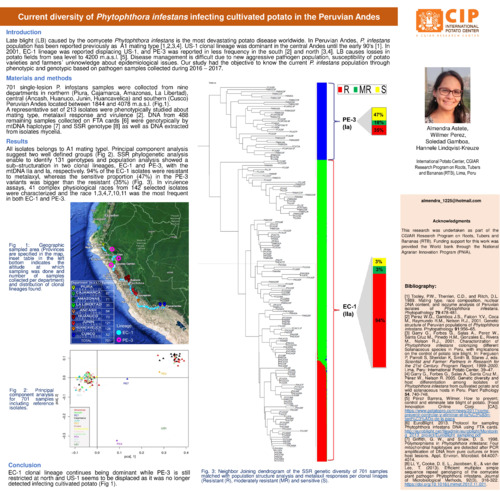Current diversity of Phytophthora infestans infecting cultivated potato in the Peruvian Andes
Abstract
Late blight caused by P. infestans is the most devastating disease of potato worldwide. To understand the current P. infestans population structure in the Peruvian Andes, 701 single-lesion samples were collected from cultivated potato in different agroecological zones at 2016-2017. Genetic diversity was analyzed using the 12-plex SSR markers kit and mtADN. Phenotypic diversity was characterized for mating type, metalaxyl resistance and virulence. SSR analysis showed that population consists of EC-1 and PE-3 clonal lineages variants, that have the mtADN IIa and Ia, respectively. All isolates were A1 mating type. 94% of the EC-1 variant isolates were resistant to metalaxil, whereas the sensitive proportion (47%) in the PE-3 variants was bigger than the resistant (35%). Furthermore, virulence assays detected 41 complex physiological races from 142 selected isolates, the most frequent physiological race was 1,3,4,7,10,11 in both EC-1 and PE-3 variants. Phylogenetic analysis evidenced that isolates share identical SSR genotypes and physiological races in distant regions, that suggests that migration could have occurred. Additionally, no detection of A2 mating type indicate that population reproduction must be asexual. EC-1 clonal lineage continues to dominate across the Peruvian Andes, since 91% of the isolates were variants of this clonal lineage. The US-1 clonal lineage reported at 2001, appears to be displaced as it was no longer detected infecting cultivated potato.

